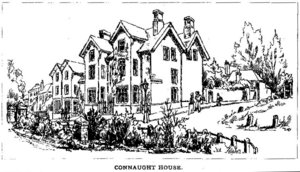Industrial school (Great Britain) facts for kids
The Industrial Schools Act was a law in England from 1857. It aimed to help children who were homeless or neglected. The idea was to move these children from the streets to special boarding schools. These schools taught them skills and tried to prevent them from getting into trouble.
Similar schools were set up in Scotland after their own Industrial Schools Act in 1866. For example, the Glasgow Industrial School for Girls started in 1882. These schools were different from "reformatories," which were more like prisons for young people who had committed crimes. By 1927, both types of schools became known as "approved schools."
In Ireland, the Industrial Schools (Ireland) Act 1868 created similar schools. They looked after children who were neglected, had no parents, or were abandoned. By 1884, over 5,000 children were living in these places.
Contents
What Were Industrial Schools?
Industrial schools were started by volunteers to help children who had nowhere to go. They believed that just teaching children in a classroom wasn't enough. These children needed to be taken away from difficult street life. They also needed to learn how to work hard and gain a useful skill or trade.
Some of these schools were places where children lived, like a boarding school. Others were for children who came just for the day. The daily schedule was very strict. Children woke up early, around 6:00 AM, and went to bed by 7:00 PM.
During the day, there were set times for religious lessons and moral guidance. There was also formal schooling, doing chores around the school, eating, and learning trades. Children also had three short breaks for play. Boys often learned gardening, tailoring, or shoemaking. Girls learned housework, washing, knitting, and sewing.
The Industrial Schools Act of 1857
Quick facts for kids Industrial Schools Act 1857 |
|
|---|---|
| Act of Parliament | |

|
|
| Citation | 20 & 21 Vict. c. 48 |
The Industrial Schools Act 1857 gave magistrates (judges) the power to send homeless children to an industrial school. These were children between 7 and 14 years old who were brought to court for being homeless or wandering the streets.
In 1861, the law was made even stronger. Magistrates could send children to these schools if they were:
- Found begging for money or charity.
- Wandering without a home or way to support themselves.
- With people known to be thieves.
- Under 12 years old and had committed a small crime.
- Under 14 years old and their parents said they couldn't control them.
At the time, it was hard to know a child's exact age. Births didn't have to be registered until 1875. Children who were homeless often didn't know their own age.
Children who were homeless but hadn't committed serious crimes went to industrial schools. Children who had been arrested for other crimes went to reformatories, which were like juvenile prisons.
Who Paid for the Schools?
The original idea was that parents would pay for their children to attend these schools. However, many children were sent there because they were already homeless. So, the government often had to pay. The system grew very quickly. Judges often preferred to send children to a school rather than a reformatory.
But people started to worry about how much money this was costing. From 1870, local education committees became responsible for the industrial schools.
At their busiest time, there were about 224 certified industrial schools in England and 50 in Scotland. Some schools operated without official approval. After World War I, many schools closed down. By 1933, only 55 were left. In 1927, they all agreed to change their names to "approved schools." The Approved Schools Act 1933 then combined them into one system.
See also
- Haut de la Garenne, an industrial school in Saint Martin, Jersey, started in 1867


